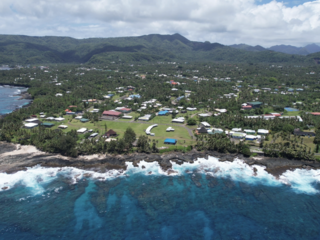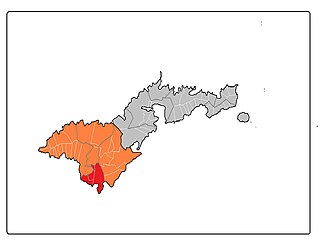
Politics of American Samoa takes place in a framework of a presidential representative democratic dependency, whereby the governor is the head of government, and of a pluriform multi-party system. American Samoa is an unincorporated and unorganized territory of the United States, administered by the Office of Insular Affairs, U.S. Department of the Interior. Its constitution was ratified in 1966 and came into effect in 1967. Executive power is discharged by the governor and the lieutenant governor. Legislative power is vested in the two chambers of the legislature. The party system is based on the United States party system. The judiciary is independent of the executive and the legislature.

Politics of Samoa takes place in a framework of a parliamentary representative democratic state whereby the Prime Minister of Samoa is the head of government. Existing alongside the country's Western-styled political system is the faʻamatai chiefly system of socio-political governance and organisation, central to understanding Samoa's political system.

The New Jersey Legislature is the legislative branch of the government of the U.S. state of New Jersey. In its current form, as defined by the New Jersey Constitution of 1947, the Legislature consists of two houses: the General Assembly and the Senate. The Legislature meets in the New Jersey State House, in the state capital of Trenton.

The California State Senate is the upper house of the California State Legislature, the lower house being the California State Assembly. The state senate convenes, along with the state assembly, at the California State Capitol in Sacramento.

The American Samoan Legislature or Fono has two chambers, the House of Representatives and the Senate, which has a directly elected head of government, the Governor of American Samoa.

The Florida Senate is the upper house of the Florida Legislature, the state legislature of the U.S. state of Florida, the Florida House of Representatives being the lower house. Article III, Section 1 of the Constitution of Florida, adopted in 1968, defines the role of the Legislature and how it is to be constituted. The Senate is composed of 40 members, each elected from a single-member district with a population of approximately 540,000 residents. The Senate Chamber is located in the State Capitol building.
The Senate was the upper house of the Parliament of South Africa between 1910 and its abolition from 1 January 1981, and between 1994 and 1997.

The Alabama State Senate is the upper house of the Alabama Legislature, the state legislature of the U.S. state of Alabama. The body is composed of 35 members representing an equal number of districts across the state, with each district containing at least 127,140 citizens. Similar to the lower house, the Alabama House of Representatives, the senate serves both without term limits and with a four-year term.

The Legislative Assembly, also known as the Parliament of Samoa, is the national legislature of Samoa, seated at Apia, where the country's central administration is situated. Samoan Parliament is composed of two parts: the O le Ao o le Malo and the Legislative Assembly.

The American Samoa Fono is the territorial legislature of American Samoa. Like most states and territorial legislatures of the United States, it is a bicameral legislature with a House of Representatives and a Senate. The legislature is located in Fagatogo along Pago Pago harbor.

The American Samoa House of Representatives is the lower house of the American Samoa Fono. The House consists of 21 members serving two-year terms, with 20 popularly elected representatives, and one delegate from Swains Island elected in a public meeting.

American Samoa is administratively divided into three districts and two unorganized atolls. The districts are subdivided into 15 counties, which are composed of 76 villages.
The government of American Samoa is defined under the Constitution of American Samoa.

Faʻamatai is the indigenous political ('chiefly') system of Samoa, central to the organization of Samoan society. It is the traditional indigenous form of governance in both Samoas, comprising American Samoa and the Independent State of Samoa. The term comprises the prefix faʻa and the word matai.
Nua Mailo Saoluaga is an American Samoan politician. He served as the Speaker of the American Samoa House of Representatives from 1997 until 2002, and as a Senator from 2013 to 2021.
Tuanaitau Fa'atamala Tuia was an American Samoan politician and the longest-serving member of the American Samoan territorial legislature, the Fono, in history. Tuia served a combined 49 years in the Fono, including thirty years in the American Samoa House of Representatives and seventeen years in the Senate.

Vailoatai is a village in southwestern Tutuila, the main island of American Samoa. It is located on the eastern end of Leone Bay. The village is known for its beautiful malae, nested along the island's rugged southern coast and lined by the fale tali mālō of its village chiefs.

The Fono of Faipule was a legislature in Western Samoa during the colonial era. It consisted of representatives (faipule) from each district.

Tuālā-tai County is one of the five counties that make up the Western District of American Samoa.

Legislative elections were held in American Samoa between 19 and 24 January 1953, the first under universal suffrage.












